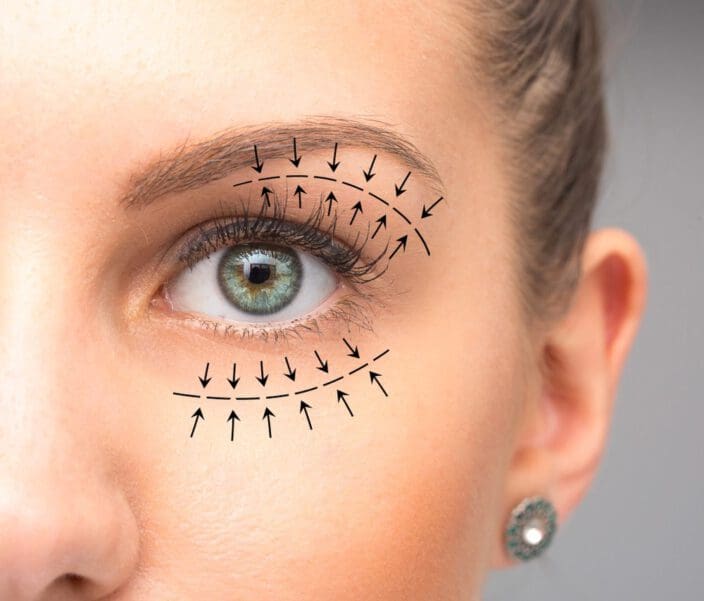Blepharoplasty Surgery: Costs, Recovery, & More
Home / Laser Eye Surgery Guide (Updated) /
Last Updated:
Blepharoplasty is a surgical procedure that is outpatient, so you can return home to start healing the day of your operation. This medical procedure removes excess skin, fat, or muscle from around your eyes or eyelids to give you a more youthful appearance and reduce drooping eyelids.
Whether you simply want to improve your appearance or sagging skin has reduced your peripheral vision, blepharoplasty is still a type of surgery, so there are risks associated with it. Some side effects include problems from general anesthesia, pain, infection, bleeding, or reduced or lost vision. However, these side effects are rare.
Most people heal in about two weeks if they follow their surgeon’s instructions.
What Is Blepharoplasty?
Blepharoplasty is an outpatient surgical procedure that repairs drooping eyelids, either for cosmetic or functional reasons. This may involve the removal of excess fat, skin, or muscle around the eyes.

You may be a good candidate for blepharoplasty if you have any of the following conditions:
You deserve clear vision. We can help.
With 135+ locations and over 2.5 million procedures performed, our board-certified eye surgeons deliver results you can trust.
Your journey to better vision starts here.
- Baggy skin under the eye
- Excess skin or fat under the eye
- Sagging or drooping upper eyelids
- Excess skin around the eyes that interferes with peripheral vision
Insurance may not cover the procedure if it is entirely for cosmetic reasons. There are some conditions for which a blepharoplasty is medically necessary, and insurance should cover at least part of the procedure.
Blepharoplasty: Cosmetic vs. Functional

Your eye doctor may recommend eyelid surgery for functional reasons, such as vision improvement. You may also seek out this procedure for cosmetic purposes.
Cosmetic Blepharoplasty
The main reason for cosmetic blepharoplasty is to improve your visual appearance if you have droopy or baggy upper or lower eyelids. Unless your doctor has identified abnormalities in your vision as a result of excess sagging eyelid skin, this procedure is considered elective – medically unnecessary.
Your surgeon will remove the excess skin during the cosmetic procedure and also may remove any fatty tissue around the eyelid to improve the openness and attractiveness of your eyes and face.
In many cases, stretched eyelid skin and loose muscles contribute to droopy eyelids. The surgeon can tighten the muscles and surrounding tissues to give your eyelid area a better defined, youthful appearance.
Lower lids with excess fat or loose tissue don’t usually cause functional or medical problems. As such, lower lid blepharoplasty is nearly always a cosmetic intervention.
Functional Blepharoplasty
Sometimes loose upper eye skin can sag so much that it causes vision impairment. If you experience any vision issues because of droopy eyelids – such as difficulty reading or seeing well when you’re driving – you may need functional blepharoplasty.
This procedure can also benefit people who struggle to wear glasses or contact lenses because of thjeir fatty upper or lower eyelids.
Similarly, skin care experts warn that any vigorous or prolonged rubbing of baggy eyelid skin can cause irritation and other medical issues. Any excess folds can be surgically removed to solve the problem.
You may not be a good candidate for blepharoplasty if you have:
- Medical conditions that affect how fast you heal, like diabetes.
- Dry eye syndrome.
- Heart or circulation problems.
- Skin conditions.
- Other medical issues that make general anesthesia not good for you.
Risks Associated With Blepharoplasty

- Bleeding
- Infection
- Dry, irritated eyes
- Trouble closing your eyes
- Other problems with the eyelids
- Noticeable scars
- Injury to the eye muscles
- Discoloration of the skin
- The need for follow-up surgery to correct a surgical error
- Temporarily blurred vision
- Damage to the eyeball
- Short-term or long-term lost vision
- Issues from anesthesia
- Potential for blood clots
- Malpositioned eyes
- Undercorrection or overcorrection
- Loss of nerve sensitivity in the eyelid
Preparing for Your Blepharoplasty
If you decide to pursue blepharoplasty, or your ophthalmologist thinks it is a good choice to improve your vision, you will first meet with a plastic surgeon, an ophthalmologist, or an ocuplastic surgeon to discuss the procedure.
The surgeon will take your medical history, so they understand how general anesthesia and other risks will impact your recovery time. They will also discuss your expectations for appearance and healing after the operation.
Then, you will undergo a few diagnostic exams.

- You’ll have a general physical examination to ensure you are healthy.
- You’ll also have a visual examination of both central and peripheral vision.
- Photos of your eyelids will be taken from different angles, which helps the surgeon plan where incisions will go and assess how long recovery will be.
Based on this information, they may be able to tell you if insurance will cover the operation.
Before your surgery, you will be asked to:
- Stop taking blood thinner medications, aspirin, ibuprofen, some other nonsteroidal anti-inflammatory drugs (NSAIDs), and some herbal or dietary supplements that affect your blood clotting ability.
- Quit smoking several weeks before the procedure.
- Ensure you have someone who can safely drive you home and stay with you the first night.
Although blepharoplasty is an outpatient operation, you will still have effects from anesthesia that require support to get home and stay safe.
You deserve clear vision. We can help.
With 135+ locations and over 2.5 million procedures performed, our board-certified eye surgeons deliver results you can trust.
Your journey to better vision starts here.
During the Surgery
During the procedure, your surgeon will mark the incision sites and remove any excess skin, fat, or muscle. Blepharoplasty can remove tissue from the upper lids, lower lids, or both, although removing skin from both lids at the same time is rare.
After the operation, you will spend some time in the recovery room as most anesthesia leaves your body, and you can be monitored for any potential complications.
Blepharoplasty with Ptosis Surgery
An eye doctor sometimes may suggest two procedures – blepharoplasty and ptosis surgery – to someone who has droopy eyelids. Such a recommendation is usually medically necessary when the patient has ptosis (their drooping eyelid falls low enough to partially cover the pupil).
The affected eye will experience poor upper vision as a result. This condition (ptosis) generally occurs when the tendon of the muscle that keeps the eyelid in position stretches, causing the eyelid to fall.
Before restoring the eyelid to its normal position, the surgeon first may perform blepharoplasty to remove any excess eyelid skin and surrounding tissue.
Then, during ptosis eyelid surgery, the surgeon will repair the stretched tendon and adjust the eyelid’s lifting muscle. Your specialist also may tighten the levator muscle by shortening it before reattaching it to the eyelid.
This two-pronged approach not only corrects droopy eyelids but also solves vision problems and leaves patients with a better overall appearance around the eyes. Patients often look younger following the corrective procedures.
Postoperative Care

Once you get home, you will experience temporary side effects including:
- Blurry vision, especially from the lubricated ointment the doctor will prescribe for you.
- Watering eyes.
- Sensitivity to light.
- Double vision.
- Puffy, numb, or aching eyelids.
- Swelling and bruising that looks like you have a black eye.
- Discomfort or pain, which will be managed for a few days with prescription painkillers.
To combat these side effects, you may use cold compresses for about 10 minutes every hour for the first night after the operation. The next day, use ice packs on your eyes four or five times over the course of the day, but swelling and discomfort should already be noticeably lower.
You will receive prescription eye drops and/or ointment to keep the skin around your eyes elastic and your eyes lubricated. Gently clean your eyelids as your doctor orders.
Avoid strenuous activities like heavy lifting, aerobic exercise, or swimming for at least a week or as long as your doctor recommends. Avoid rubbing your eyes, do not use your contact lenses for two weeks after surgery, and do not start smoking again.
If swelling continues after a few days, apply cold compresses to reduce discomfort. If it does not go away, contact your surgeon or ophthalmologist immediately. Additionally, if you experience any symptoms like an allergic reaction or chest pain, get emergency medical attention.
When you leave the house, wear darkly tinted sunglasses, preferably with protection from ultraviolet light. These keep your eyes safe from bright light and wind.
If your surgeon used stitches to seal wounds, return to have those removed if necessary. Avoid wearing makeup for a few weeks, even after stitches are removed or until your doctor says it is okay to wear it again.
Healing typically takes about two weeks. Work with your ophthalmologist and surgeon to ensure you understand individual factors that impact the speed at which you heal and when it is okay to return to daily activities like work, school, driving, or exercise.
Important Questions to Ask Your Doctor or Ophthalmologist
If you’re considering eyelid surgery, you should ask your doctor some key questions to boost your confidence about the procedure and to help you make an informed choice. It’s important that you ask your specialist to clarify any surgical risks and outcomes that can apply to your condition.
You can seek out clarification on concerns such as:
- Am I a good candidate for blepharoplasty based on my medical history?
- Which type of eyelid surgery do I require to restore my impaired vision?
- What can I expect after surgery, and will the cosmetic outcomes last?
- Will I ever need eyelid surgery again?
- What are the possible blepharoplasty side effects and risks?
- Are you a certified and experienced ophthalmologist or eye surgeon?
Having a candid conversation with your eye doctor enables you to set realistic expectations and minimize the possibility of post-surgery disappointment.
You deserve clear vision. We can help.
With 135+ locations and over 2.5 million procedures performed, our board-certified eye surgeons deliver results you can trust.
Your journey to better vision starts here.
References
- Blepharoplasty: Overview. (March 28, 2018). Mayo Clinic.
- Droopy Eyelids. American Society for Dermatological Surgery (ASDS).
- Eyelid Surgery (Blepharoplasty) for a More Youthful Appearance. (November 2016). All About Vision.
- What to Expect From Blepharoplasty. (November 2, 2017). Healthline.
- Evidence-Based Medicine: Blepharoplasty. (May 2014). Plastic and Reconstructive Surgery.
- Blepharoplasty, Blepharoptosis Repair, and Brow Lift. (April 7, 2021). UniCare. Date fetched: August 13, 2021
This content is for informational purposes only. It may have been reviewed by a licensed physician, but is not intended to serve as a substitute for professional medical advice. Always consult your healthcare provider with any health concerns. For more, read our Privacy Policy and Editorial Policy.
